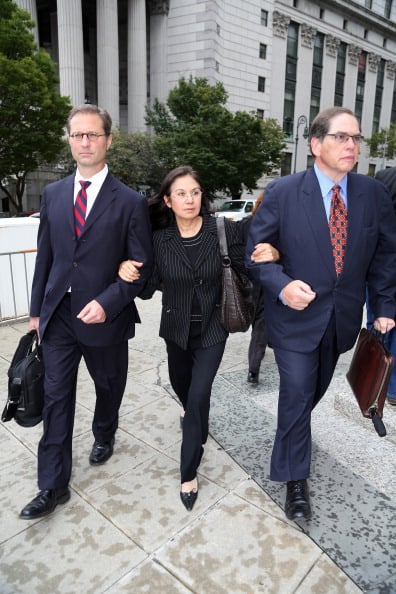Law & Politics
Glafira Rosales, Who Sold Fakes to Knoedler, Avoids More Jail Time in Fraud Case
She claimed "abuse and coercion" by a co-conspirator.

She claimed "abuse and coercion" by a co-conspirator.

Brian Boucher &
Eileen Kinsella

Another chapter has closed in an epic art fraud case, in which New York’s Knoedler & Co. art gallery sold $80 million in artworks that were later revealed to be fakes.
Long Island art dealer Glafira Rosales, who used her car to transport to the gallery paintings supposedly by 20th-century giants like Jackson Pollock and Mark Rothko that the gallery then sold to unwitting buyers, was sentenced on Tuesday to nine months house arrest and three years probation for her part in the fraud. She entered a guilty plea to charges of wire fraud, money laundering, and tax evasion in 2013, and previously served three months in jail.
“I’m not putting you back in jail,” Judge Katherine Polk Failla told Rosales Tuesday afternoon at United States District Court for the Southern District of New York in Lower Manhattan. “There would be no purpose served in putting you back in jail.” In deciding the sentence, she said, she heavily weighed Rosales’ testimony that she was coerced into the crime and that she cooperated with the authorities after her arrest.
Also weighing heavily on the judge’s decision, she said, was the presence of Rosales’s daughter Isolina. As Rosales’ lawyer, Bryan Skarlatos of Kostelanetz & Fink, argued, her boyfriend and the father of her daughter, José Carlos Bergantiños Diaz, put her up to the scheme and threatened to flee to Spain with their daughter if Rosales went to the authorities. He also threatened both their lives after fleeing to Spain himself, Skarlatos said.
“Your concern for her would exactly motivate what you did,” said the judge in explaining her leniency, saying that the mutual concern between mother and daughter had become clear to her only by seeing them together in the courtroom.
In a last-minute legal filing, Rosales claimed that Diaz cooked up the entire fraudulent enterprise and threatened her life in order to keep her from backing out of the plan, according to the New York Post. Skarlatos also pointed out that Rosales was raised by an abusive father, making her vulnerable to Diaz’s abuses, another factor Failla said factored into her decision to depart from sentencing guidelines that would have allowed a sentence ranging from twelve and a half to fifteen years.
“I apologize to you, to my daughter, to my family, to my friends, and to all those affected” by her crime, Rosales said through tears. “I’ve had many hardships but none of that excuses what I have done. I am truly, truly sorry. I have no words … I’m so sorry.”
Diaz was arrested in Spain in 2014. Two years later, Spain’s national court turned down attempts to extradite him and his brother Jesus Angel Bergantiños Diaz to the US, as the latest filing notes. The painter he hired to create the fakes, Pei-Shen Qian, who was also named in the US Justice Department’s indictment, fled to China.
The sentencing letter, filed on January 17, claims that Diaz cooked up the plan when he himself was no longer able to work as an art dealer because “people in the art world eventually began to question [the] authenticity” of the works he was offering. It points out that at 60 years old, Rosales “finds herself working as a busgirl in a restaurant, struggling to live on a minimal salary and barely able to pay her medical expenses.” Skarlatos noted that he was representing Rosales pro bono.
The filing also contains letters from friends and family that purport to “demonstrate the profound effect this case has already had on Glafira including the extreme remorse and shame she feels and the financial devastation she will live with for the rest of her life,” in pleading for a more lenient sentence.
The gallery and its former director, Ann Freedman, have settled in more than one multimillion-dollar case. Collectors Eleanore and Domenico De Sole settled a lawsuit against the gallery in February 2016 after a years-long legal action over a painting for which they paid $8.4 million and was sold to them as a Rothko. At the same time, it emerged that the gallery had settled a suit brought by hedge fund manager Pierre LaGrange over a fake Pollock for just $6.4 million after LaGrange had spent $17 million on the canvas. There were nine lawsuits against Freedman and the gallery in all.
Skarlatos, in pleading for his client, pointed out that evidence provided by Rosales was key in allowing civil cases to go forward.
John Cahill, an attorney specializing in art law who handled a case for John Howard, a collector who eventually settled over the purchase of a multimillion-dollar fake Willem de Kooning, told artnet News via email:
From our standpoint, Rosales reveled in and enjoyed the millions of dollars that she stole through her role in Knoedler forgery fraud. Not once did she do anything to help its victims or even to express remorse. To the contrary, she stood silent and refused to do anything to help in the victims obtain relief and justice.
“It is my hope,” Judge Failla told Rosales, “that you and I will not see each other under these circumstances again.”